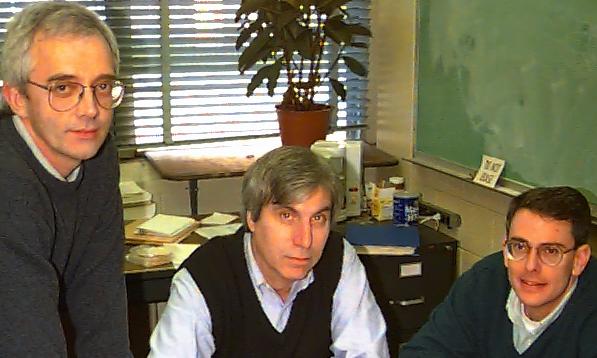 1. Code Name: TSC--Tokamak Simulation code
1. Code Name: TSC--Tokamak Simulation code
 1. Code Name: TSC--Tokamak Simulation code
1. Code Name: TSC--Tokamak Simulation code
2. Category: IIId. Global Transport Timescale
3. Responsible Physicist: S. Jardin (center)
4. Others involved in code development: N. Pomphrey (left), C. Kessel (right)
5. One line description: Free boundary evolving equilibrium transport timescale code.
6. Computer systems which code runs on: NERSC, DEC-alpha
7. Typical running time: 20 minutes-2 hours on NERSC C-90. 5 times slower on DEC-alpha
8. Approximate number of code lines: 35000
9. Does this code read data files from another code? If so explain. Yes, can read experimental data files ENINA written by TFTR, PBX, D-IIID in data comparison mode.
10. Does this code produce data files that can be read by another code? If so, explain. Yes, can write files JAYPHA & WIREFA for disruption studies, DIVHISA for divertor studies, LHCDOUA for lower hybrid studies, and EQDSKA for stability studies.
11. 1-2 paragraph description of code: TSC is the Tokamak Simulation Code developed at PPPL and used extensively at Princeton and throughout the world. It can model the evolution of a free-boundary axisymmetric tokamak plasma on several different time scales. The plasma equilibrium and field evolution equations are solved on a two-dimensional Cartesian grid, while the surface-averaged transport equations for the pressures and densities are solved in magnetic flux coordinates. An arbitrary transport model can be used, but the Coppi-Tang model is used most frequently. Neoclassical-resistivity, bootstrap-current, auxiliary-heating, current-drive, alpha-heating, radiation, pellet-injection, sawtooth, and ballooning-mode transport models are all included. As an option, circuit equations are solved for all the poloidal field coil systems with the effects of induced currents in passive conductors included. Realistic feedback systems can be defined to control the time evolution of the plasma current, position, and shape. Required voltages for each coil system can be output as part of a calculation. Vertical stability and control can be studied, and a disrupting plasma can be modeled. TSC can also be run in a "data comparison" mode, in which it reads specially prepared data files for the PBX-M, TFTR, or DIII-D experiments. For each of these, a special postprocessor to directly compare TSC predictions with both magnetics and kinetics data for particular shots from these experiments. In all modes, TSC calculates the ballooning-mode stability criteria internally, and it also writes files that are read by the PEST code to calculate ideal and resistive stability for low-n mode.
12. Similar codes to this code, and distinguishing differences: Similar to BALDUR, but is free boundary and simultaneously solves circuit equations.
13. Journal References describing code (up to 3):
Jardin, S. C. DeLucia, J. L., Pomphrey, N., J. Comput Phys. 66 481 (1986).
Jardin, S. C. et al, Nucl. Fusion 27 569 (1987).
Jardin, Bell, and Pomphrey, Nucl. Fusion, 33, page 371 (1993)
Jardin, Kessel, and Pomphrey, Nuclear Fusion Vol 34 page 1145 (1994)
14. New code capabilities planned for next 1-2 years: New lower hybrid heating package being upgraded to include fast waves. New version, TSC-II. to appear in 1996 which is more efficient, and has greater flexibility in control-system specification.
15. Code users: S. Jardin, N. Pomphrey, C. Kessel (PPPL), R. Sayer (ORNL), J. Ramos(MIT), D. Ward (CRPP), T. Kaiser (LLNL), B. Merrill (EGG), M. Shoucri (Hydro-Quebec, Canada), N. Schneider (IPP, Garching), F. Hofmann (EPFL).
16. Present and recent applications of code: BPX design, TCV design, PBX analysis, extensive TPX and ITER analysis
17. Status of code input/output documentation:Check one:
( ) does not exist
( ) incomplete
(X) exists ;
see also tscman.pdf (640 kB)
and tscman.ps.gz (270 kB).
18 Year Code was first used and present frequency of use: 1986 This code is used extensively by many people every day
19. Estimate of Man-Years invested in developing code: 10
20. Categories of usage of Code (Check all that apply): (x) application code to do analysis and prediction of experiments (x) numerical testbed of theoretical ideas ( ) physics module to be used in integrated moddelling (x) code for machine design
21. Language code is written in: Fortran
22. Results of intercomparisons with other codes and results of validation against experiments.
Comparison with TFTR in Nucl. Fus., Vol 33, page 371 (1993)
Comparison with PBX in Nucl Fusion Vol 27, page 569 (1987)
Comparison with TFTR in Fusion Engin and Design Vol 15 p 163
(1991)
Comparison with PBX in Kaita, et al, IAEA paper 1992
Comparison with DIII in Nucl. Fusion Vol 33, p 969 (1993)